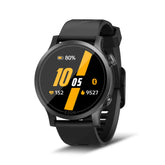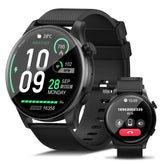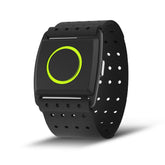Altitude Training for Runners: Oxygen Monitors and Acclimation Tips
Prepare to conquer high-altitude races with science-backed strategies! Blood oxygen monitor watches are essential tools for tracking oxygen saturation levels during altitude training, while smart acclimation plans help runners avoid altitude sickness and optimize performance. This guide reveals how to use wearable tech and progressive training to thrive in low-oxygen environments.
1. The Science of Altitude Training for Runners
A. How Altitude Impacts Performance
- Oxygen Deprivation Basics: At 2,500m, oxygen levels drop by 25%, reducing aerobic capacity and increasing heart rate by 10–15 BPM.
- Acclimation Benefits: 2–3 weeks of proper training can boost red blood cell production by 10–15%, improving oxygen delivery to muscles (Journal of Applied Physiology).
B. Blood Oxygen Monitor Watch Role
- SpO₂ Tracking: Monitors oxygen saturation (normal range: 95–100%). A drop to <90% signals altitude stress.
- Heart Rate Variability (HRV): Low HRV (<40) combined with low SpO₂ indicates need for rest—use watches like EZON Focus Series to track real-time data.
2. Essential Tools: Blood Oxygen Monitor Watches
A. Key Features for Altitude Training
- Medical-Grade SpO₂ Sensors: Dual-wavelength LEDs (red + infrared) for accurate readings in cold conditions.
- Altimeter & Barometer: Predict weather changes and track elevation gain/loss during training runs.
- Altitude Sickness Alerts: Watches like EZON Altitude Pro trigger warnings when SpO₂ drops below 92% for >10 minutes.
B. Top Watches for Altitude Training (Under $200)
| Model | SpO₂ Accuracy | Altitude Range | Battery Life | EZON Link |
|---|---|---|---|---|
| EZON Focus 3 | ±2% | 0–5,000m | 15hr (GPS) | Shop Now |
| Garmin Instinct | ±3% | 0–6,000m | 24hr (GPS) | N/A |
| Polar Grit X | ±2.5% | 0–4,500m | 40hr (GPS) | N/A |
3. Acclimation Training Plan: From Sea Level to High Altitude
A. 3-Week Progressive Protocol
Week 1: Base Altitude (1,500–2,000m)
-
Daily Routine:
- 30–45 min easy runs at 60–70% MHR, monitoring SpO₂ (should stabilize at 92–94%).
- Use blood oxygen monitor watch to log morning SpO₂—aim for <5% daily variation.
Week 2: Intermediate Altitude (2,500–3,000m)
-
Intensity Training:
- 2x/week interval runs: 4x800m at race pace, with 2-min rest (keep SpO₂ >90% during intervals).
- Sleep Acclimation: Spend nights at altitude but train at lower elevations if SpO₂ drops <88%.
Week 3: Target Altitude (3,500m+ for races)
-
Tapering Strategy:
- Reduce mileage by 30% while maintaining SpO₂ checks—focus on 5K race-pace efforts to simulate race stress.
4. Avoiding Altitude Sickness: Prevention Tips
A. Early Warning Signs & Responses
-
Mild Symptoms (Headache, Nausea):
- Descend 300–500m immediately; use watch alarms to drink 200ml water every 15 mins.
-
Severe Symptoms (Shortness of Breath):
- Activate watch’s SOS feature to share location; do not continue ascending until SpO₂ returns to 92%.
B. Nutrition for High Altitude
- Carbohydrate Loading: Increase carbs to 7–10g/kg body weight (e.g., 500–700g for 70kg athlete) to fuel oxygen-deprived muscles.
- Electrolyte Balance: Consume 500mg sodium/L during runs—use watch hydration reminders to avoid over/underdrinking.
5. Recovery Strategies at Altitude
A. Sleep Optimization
- Hypoxic Sleep Training: Use watch-guided breathing exercises (4-7-8 technique) to improve sleep SpO₂ by 3–5%.
- Nightly SpO₂ Monitoring: If sleep SpO₂ <85%, add an extra rest day or descend to lower altitude.
B. Active Recovery Workouts
- Low-Intensity Cross-Training: Cycling or swimming at 50–60% MHR, keeping SpO₂ above 91% as tracked by blood oxygen monitor watch.
6. Common Altitude Training Mistakes
-
Rushing Acclimation:
- Solution: Follow the 300m/day ascent rule—use watch altimeter to track daily elevation gain.
-
Ignoring Early Symptoms:
- Solution: Set watch alerts for SpO₂ <92% and HR >90% MHR simultaneously—both signal altitude stress.
-
Training Too Hard Too Soon:
- Solution: Use HRV data to guide intensity—only train above Zone 3 if HRV is >50 and SpO₂ is stable.
7. FAQs: Altitude Training for Runners
Q: How long does it take to acclimate to high altitude?
- 2–3 weeks for partial acclimation; full adaptation (max red blood cell production) takes 4–6 weeks.
Q: Can I use a regular fitness tracker for altitude training?
- No—prioritize watches with medical-grade SpO₂ sensors like EZON Focus 3—basic trackers lack altitude-specific algorithms.
Q: Best pre-race strategy for high-altitude events?
- Arrive 10–14 days before the race, spending the first 5 days at 2,000–2,500m before moving to race altitude. Use your watch to monitor daily SpO₂ improvements.
Conquer Heights with Data-Driven Training
Altitude training combines physical resilience with technological precision. By using blood oxygen monitor watches to track oxygen saturation and following structured acclimation plans, runners can minimize altitude sickness risks and unlock peak performance in high-altitude races.
Remember, the mountain doesn’t care about your training—only your preparation. Gear up with the right tools, listen to your body’s signals, and let data be your guide to conquering every elevation challenge.
EZON Watch: Precision Altitude Training Technology
https://ezonwatch.com
https://ezonwatch.com









